Pity the lives of the 'dialysis village'
(Baonghean.vn) - The old two-story house opposite Vinh Transport Hospital (Nghe An) has become the "second home" for countless dialysis patients for more than ten years. People have become accustomed to calling this place by the familiar name "dialysis neighborhood".
» Priest Nguyen Dinh Thuc incited parishioners
» Hot: A commune in Nghe An has 20 students with kidney failure, 2 of them have died
The guest house of Nghe Tinh Non-ferrous Metal Joint Stock Company located on Le Ninh Street (Quan Bau Ward, Vinh City) has been old and degraded for more than 10 years and has become the second "home" of countless dialysis patients. They come here to rent a room for convenience on their way to the Transport Hospital for dialysis. Over the same period, countless patients have come here to live, and many have passed away from this home. People come and go, turning this residential area into the "dialysis neighborhood" without anyone realizing it.
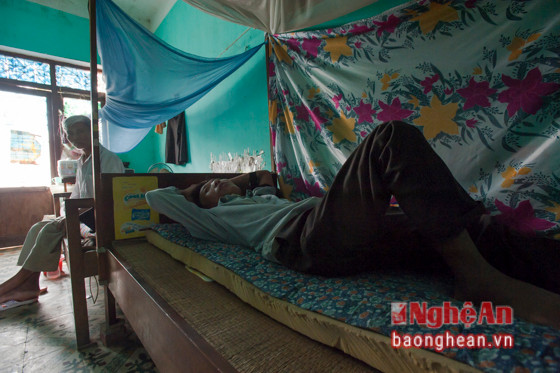 |
| A gloomy atmosphere surrounds the "dialysis village". Photo: TC |
The room in the middle of the first floor looks desolate and quiet even though there are 2 people living there, Mr. Truong Dinh Vinh and Mr. Nguyen Van Doan. Every month, they have to pay 500,000 VND for the room for both of them. Mr. Truong Dinh Vinh (Quynh Doi, Quynh Luu) is 58 years old this year but looks much older because he has been fighting kidney failure for more than 9 years. He has 4 children, his wife passed away 3 years ago. His children, some from the North and some from the South, work for hire and send money home every month for his medical treatment.
Stage 4 kidney failure has caused his ears to tinnitus, making it hard to hear clearly. Mr. Vinh's skin has become visibly darker. "Bridges" are blood transfusion sites that appear all over the 58-year-old man's wrinkled, aged arms. This is also a common condition for people on end-stage dialysis.
For over a month now, his illness has gotten worse, so Mr. Vinh has not been able to return home. “I vomit a lot, and I vomit as much as I eat. I think I am close to death,” Mr. Vinh calmly spoke about the death that awaits him. Because he knows, like many others who are staying in this house, those who have come to the “dialysis area” are determined to die, it is just a matter of whether it happens sooner or later.
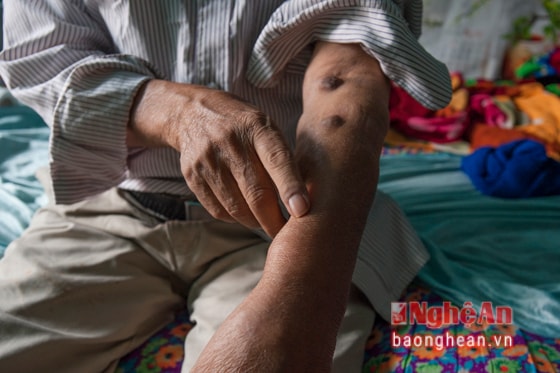 |
| FAV bridges - the place where blood is transfused - have appeared all over the wrinkled, old arms of the 58-year-old man. Photo: TT |
The "dialysis village" has had countless people come to live, and leave... forever. But here, it is mainly the elderly, people from far away districts, people with difficult family circumstances who come to rent a room. At present, the "dialysis village" has 10 patients who are all in the final stages of illness staying there. Mrs. Dao Thi Nguyen (Son Hai commune, Quynh Luu) is the oldest patient in the "dialysis village". She is 87 years old this year, and her strength is not much left, but Mrs. Nguyen has been fighting kidney failure for nearly 8 years now.
“Having blurred vision and deaf ears, after 4 hours of dialysis returning from the hospital, my mother would sit and lie down, mumbling things that no one could hear clearly. And she would constantly use her hands to continuously dig into her toenails, and no one would notice who came in or out of the room,” said Thai Thi Hoi, Mrs. Nguyen’s daughter, wiping away tears as she talked about her sick old mother. For nearly 8 years, Mrs. Hoi has left all the housework to her husband and children to come here to take care of her mother and has not left Mrs. Nguyen’s side for a single step. From eating, going to the bathroom, to taking her to the hospital for dialysis, Mrs. Hoi has done it all by herself.
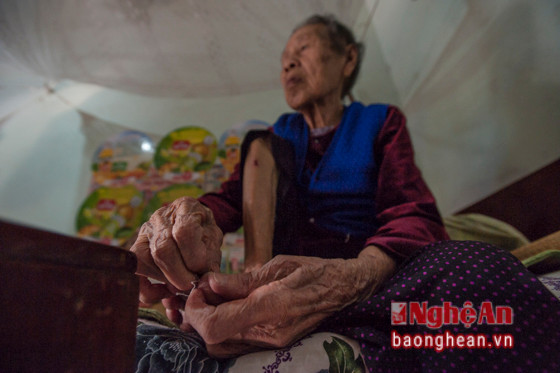 |
| Ms. Dao Thi Nguyen (Son Hai commune, Quynh Luu) is the oldest patient residing in the "dialysis village". Photo: TC |
The youngest man, also the longest-serving dialysis patient in the “dialysis village”, is Thai Khac Dan from Ky Tan commune (Tan Ky). According to other patients, Dan has the most tragic fate here. Although he is 42 years old, he has been on dialysis for more than 13 years. With a serious illness, Dan has never thought about love or marriage. He only has a 90-year-old mother in the countryside, and she also has lung cancer. Each month, he has to spend nearly 5 million VND on medicine, living expenses, etc., and he is lucky to only get a few million VND from relatives.
Mr. Dan likes to play the guitar and flute, but he hasn’t cared about them for a long time. He used to joke, “The flute is my wife,” so he only plays it when he’s sad. Before, Mr. Dan lived with two patients, but those two friends passed away a few days ago. While lighting a cigarette, Mr. Dan said, “Since Quyen and Que (his roommates) passed away, this room has become extremely cold and empty. It’s freezing cold at night!” Since losing his two friends, Mr. Dan brought a stray dog from the countryside to keep him company. He was very close to it and took it with him everywhere.
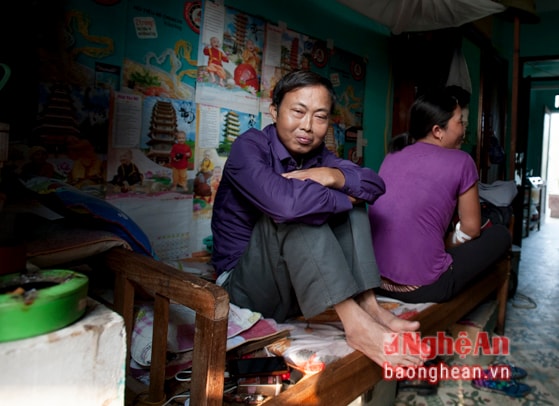 |
| With Ms. Hai coming to visit, Mr. Dan looked happy even though he didn't say it. Photo: TC |
During the last days of his life fighting a serious illness, for Mr. Dan, life was more meaningful when he had Ms. Nguyen Thi Hai (in purple shirt) as his companion. Ms. Hai is from Ha Tinh and has been staying in Nghe An for more than 6 years in the "dialysis village". Recently, Ha Tinh has had a dialysis machine so Ms. Hai stayed in her hometown to receive treatment. But occasionally, she still comes here to visit Mr. Dan, sometimes bringing him a dozen eggs, sometimes a few cartons of fresh milk.
After returning from the hospital after tiring dialysis sessions, everyone in the “dialysis neighborhood” lies flat on their beds. But sometimes the “dialysis neighborhood” gathers together in front of the first floor lobby to chat to ease the sadness. Sad because they are far from their loved ones, sad because they know “having come here, there is no way back home”. They do not have enough strength to do anything. Because one arm has a filter ball installed inside, if it accidentally breaks, it will cause the dialysis to stop, affecting the blood filtration in their body.
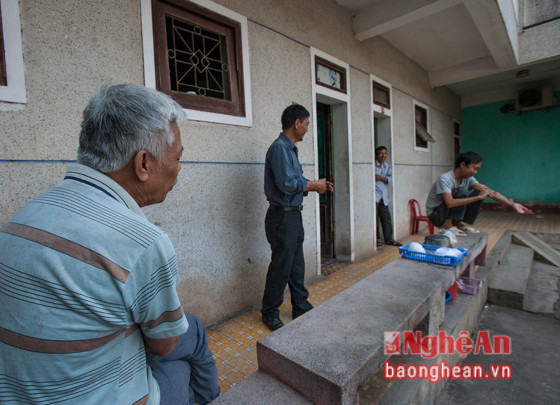 |
| After returning from the hospital after tiring dialysis sessions, the “dialysis community” sometimes gathers in front of the first floor lobby to chat. The stories sometimes make them burst into laughter... Photo: TC. |
Every kidney dialysis patient in the “dialysis village” only hopes that when they die, they will be able to see their family members. Because they know that death is just a hair’s breadth away…
Dialysisis considered a method to help treat kidney disease when kidney function is severely impaired, no longer able to excrete urine and filter blood. People withkidney failureIn the final stage, kidney function has decreased by 85 to 90%. Dialysis is the solution to help patients reduce symptoms and restore kidney function. In case of patient withacute renal failure, dialysis only needs to be performed for a short time to improve health and kidneys, then it can be stopped. For patients withchronic renal failureor end-stage renal failure, the kidneys can hardly recover their previous function. Therefore, the patient needs to go to the hospital for regular dialysis for the rest of his life. In the case of end-stage renal failure, the patient needs to undergo regular dialysis for the rest of his life, but if possiblekidney transplantthen there will be no need to do it again. To help the disease progress better and reduce the number of dialysis sessions, patients need to follow a scientific nutritional regimen.light physical activityIn moderation, take time to rest, live optimistically, comfortably or maybe seek out some natural herbs. In Vietnam, one hemodialysis session costs 500,000 VND. Hemodialysis is performed three times a week, and the patient also needs to take some additional medications such as: anti-anemia drugs, blood pressure lowering drugs, vitamins... |
Thanh Cuong - Thien Thien
| RELATED NEWS |
|---|


